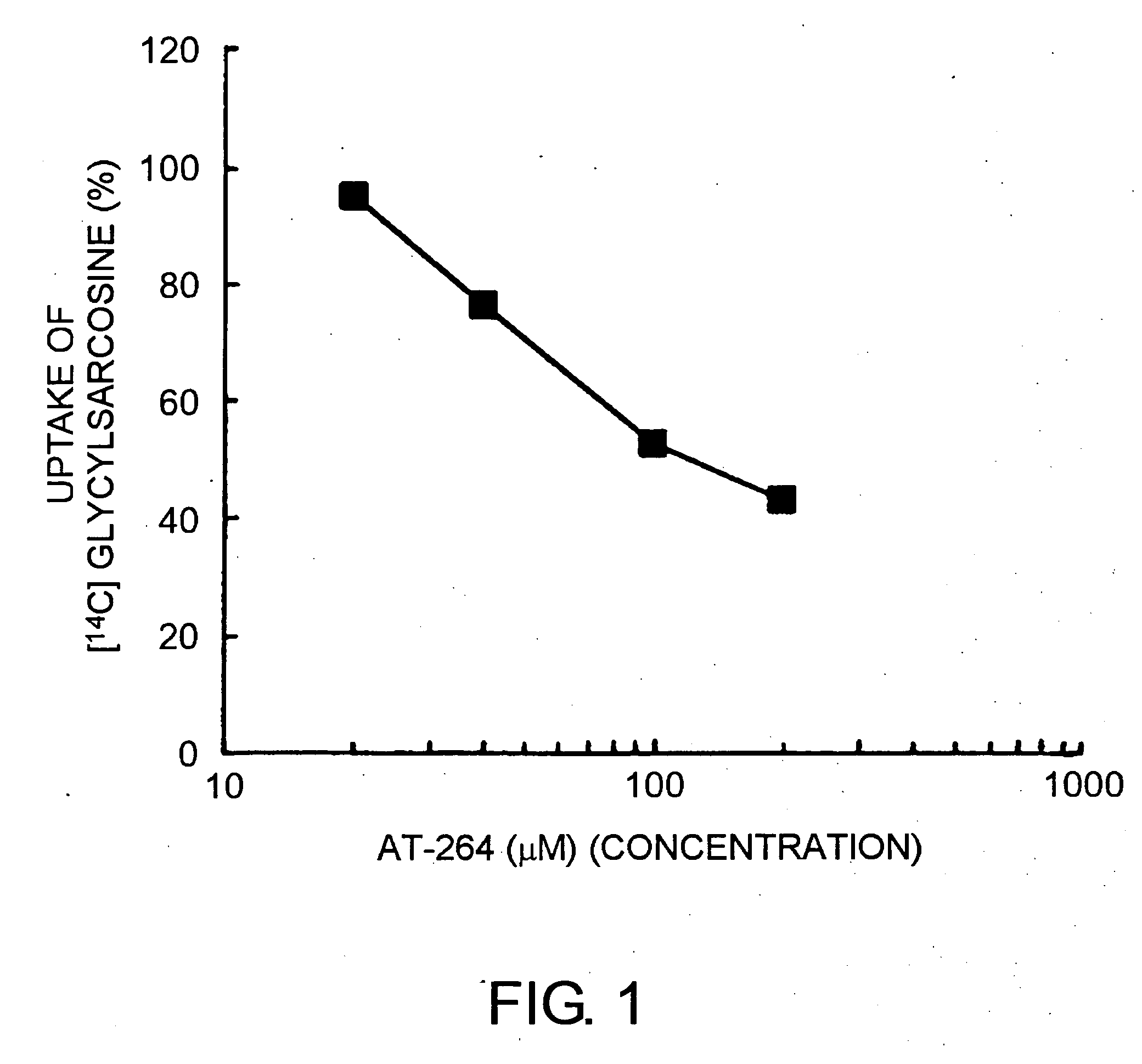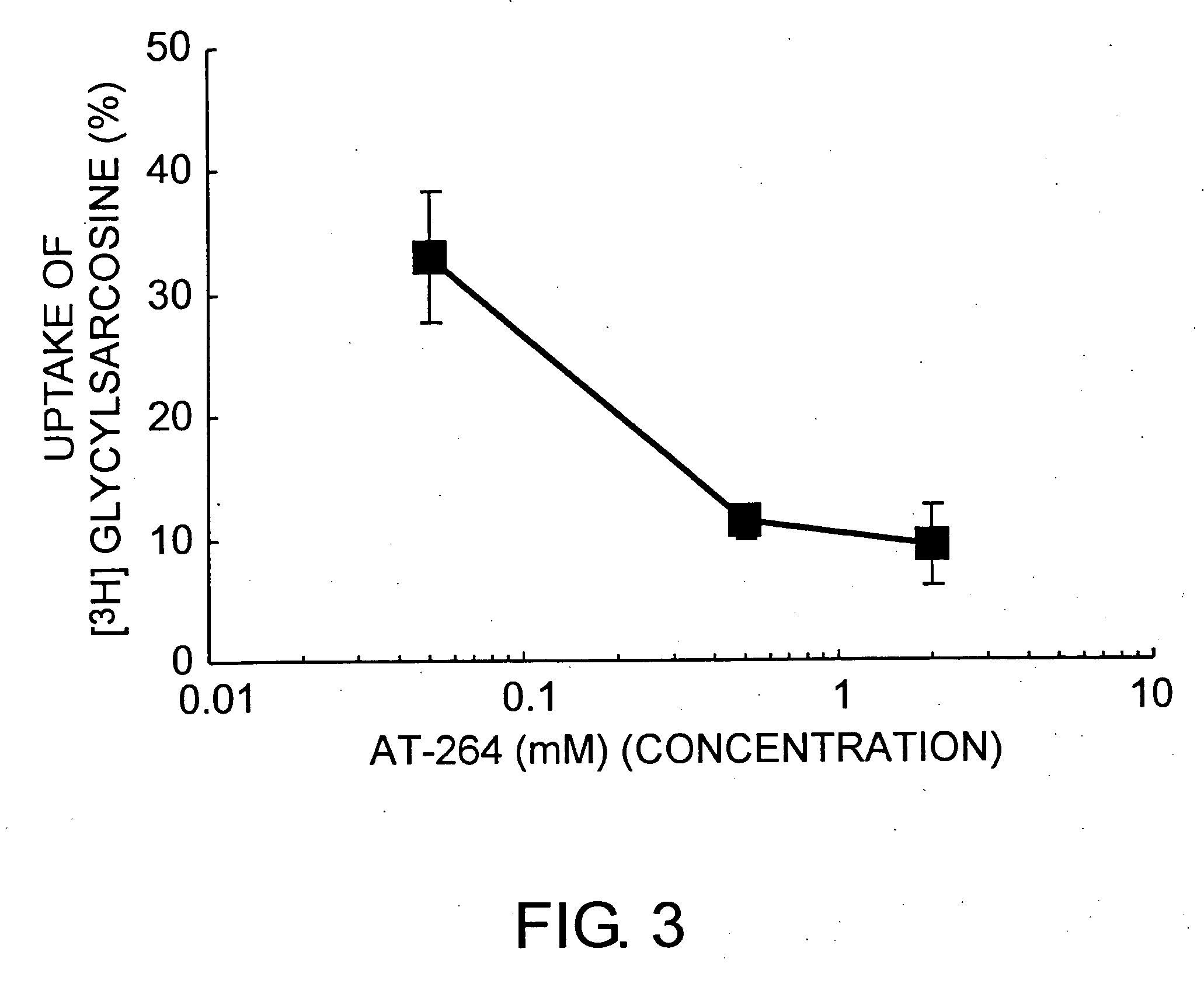Cell growth inhibitor
a cell growth inhibitor and growth factor technology, applied in the field of cell growth inhibitors, can solve problems such as no discussion
- Summary
- Abstract
- Description
- Claims
- Application Information
AI Technical Summary
Benefits of technology
Problems solved by technology
Method used
Image
Examples
example 1
Inhibitory Effect of AT-264 on PepT1 Activity
The structure of AT-264 is represented by the structural formula below. The following experiments confirmed that this compound is an inhibitor of peptide transporters (PepTs).
AT-264's ability to inhibit PepT was examined using a human colon cancer cell line (Caco-2 cells). The results were that the IC50 for uptake of radioactive substrate [14C] glycylsarcosine into cells was 100 μM (FIG. 1). In Caco-2 cells, only PepT1 was expressed, and PepT1 function was considered to be inhibited by AT-264. The purity of AT-264 used in the present experiment was approximately 50% to 60%, and the actual IC50 was thought to be about 50 μM or so.
example 2
The Cell Growth Inhibitory Effect of AT-264 Against Human Pancreatic Cancer Cell Line AsPC-1
AT-264 was dissolved in RPMI1640—10 mM Hepes (hereinafter, abbreviated to ‘the medium’) containing 0.5% ethanol and 0.5% DMSO to prepare 2.5 mM AT-264 solution. Then, this solution was diluted with the medium to prepare 0.625 mM and 0.0625 mM AT-264 solutions.
A 5×104 cells / mL solution of human pancreatic cancer cell line AsPC-1 was prepared using a medium containing 50% FBS. This suspension was plated onto a 96-well plate pre-coated with Collagen type I at 40 μL / well (2×103 cells), and 160 μL of the AT-264 solution was added. This was cultured for six days in a CO2 incubator (on the second day of culturing, 100 units / mL penicillin and 0.1 mg / mL streptomycin were added). On the sixth day of culturing, the number of viable cells was quantified by MTS assay.
The results of the cell growth experiment are shown in FIG. 2. Cell growth inhibition was confirmed to be approximately 30% in the pre...
example 3
Inhibitory Effect of AT-264 on PepT2 Activity
The ability of AT-264 to inhibit PepT2 was examined using a murine bone marrow-derived cell line BaF3 in which human PepT2 is forced to be expressed (hereinafter, abbreviated to BaF3 / PepT2). As a result, the uptake of radioactive substrate [3H] glycylsarcosine into cells was inhibited in a concentration-dependent manner (FIG. 3). Accordingly, AT-264 was found to inhibit the function of not only PepT1, but also of PepT2.
PUM
| Property | Measurement | Unit |
|---|---|---|
| energy | aaaaa | aaaaa |
| concentration | aaaaa | aaaaa |
Abstract
Description
Claims
Application Information
 Login to View More
Login to View More - R&D
- Intellectual Property
- Life Sciences
- Materials
- Tech Scout
- Unparalleled Data Quality
- Higher Quality Content
- 60% Fewer Hallucinations
Browse by: Latest US Patents, China's latest patents, Technical Efficacy Thesaurus, Application Domain, Technology Topic, Popular Technical Reports.
© 2025 PatSnap. All rights reserved.Legal|Privacy policy|Modern Slavery Act Transparency Statement|Sitemap|About US| Contact US: help@patsnap.com



